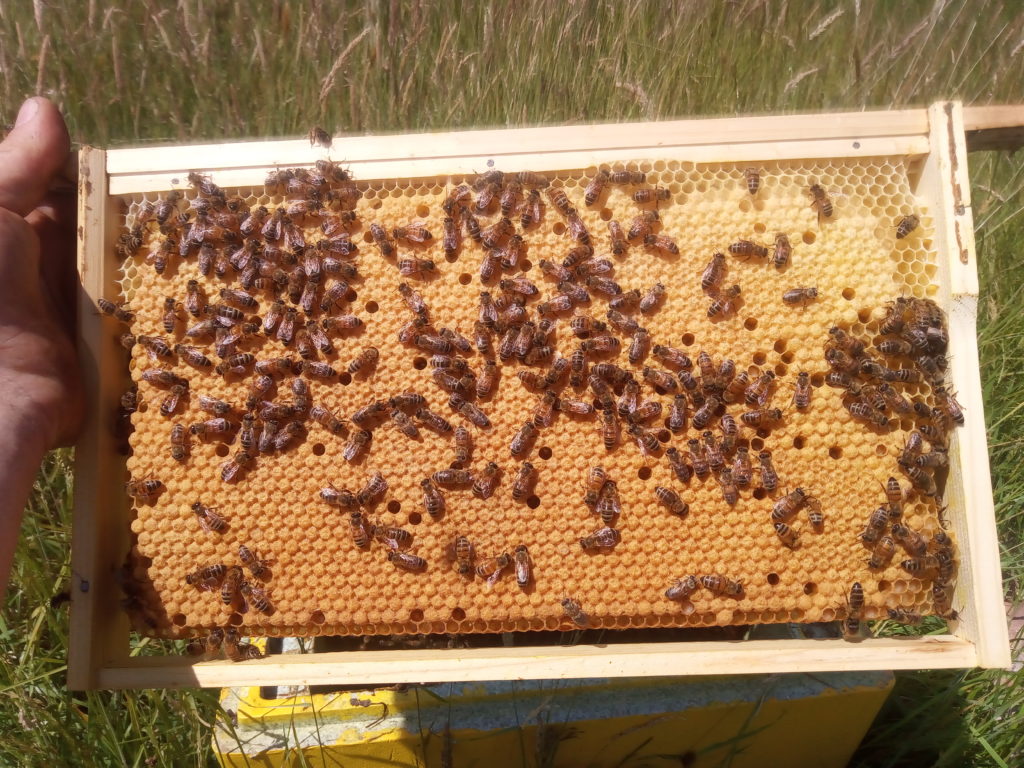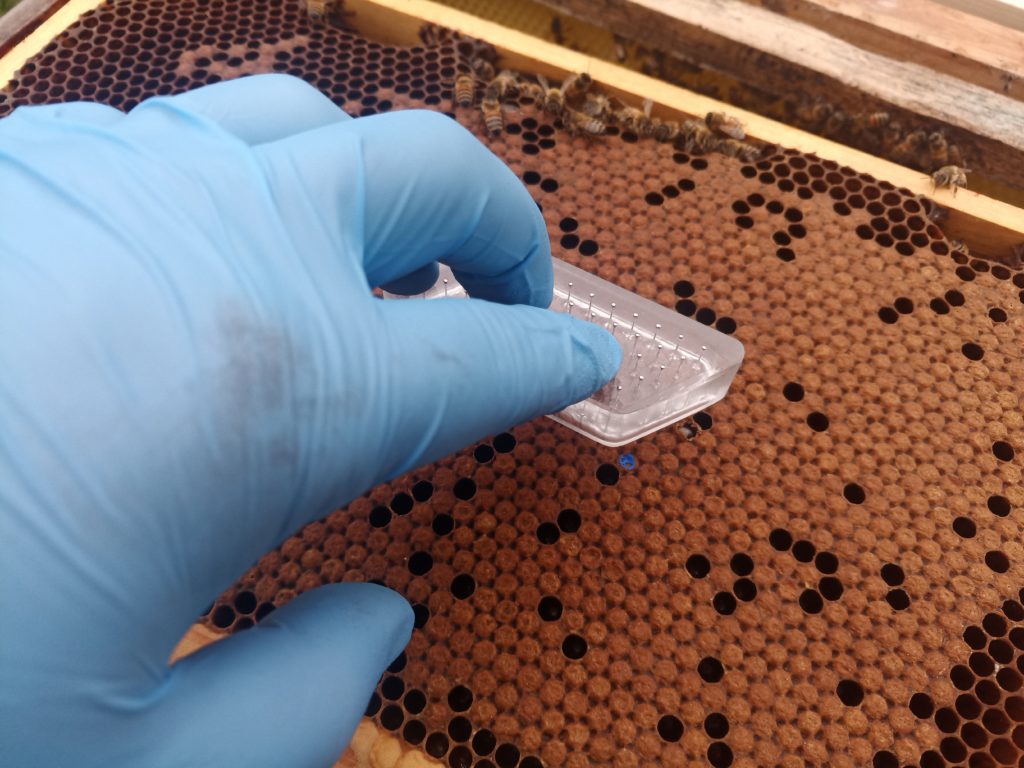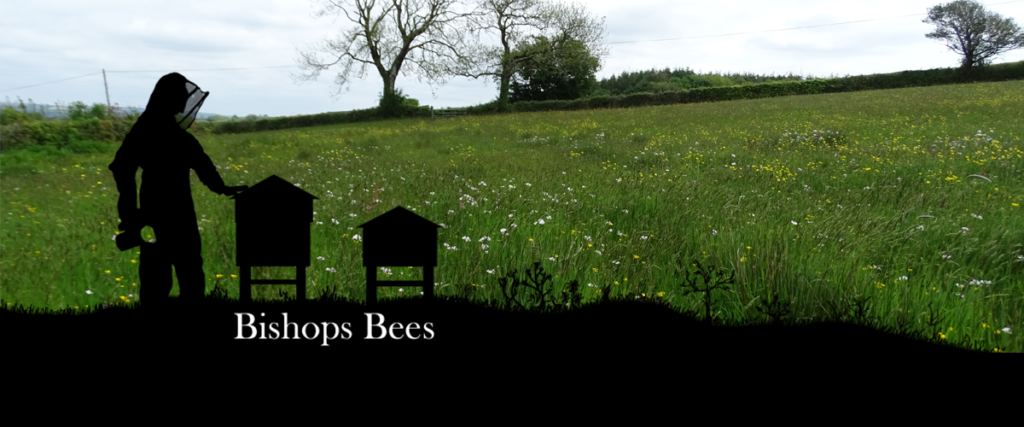Every year it seems like the queen rearing season is fast approaching. Whilst it seems like there is always an endless pile of equipment to prepare, its also important to prepare a breeding plan to help yourself stay focused and organised. This post will focus on the testing of hygienic behaviour.
Viewed as complex and confusing, hygienic behaviours are an important topic of queen breeding. However, the testing of often forms the backbone of many breeding programs. There are three distinct groups of hygienic behaviours. Hygienic behaviour refers to a colonies ability to identify and remove infected or dead pupa. This is an assessment of a colonies ability to control brood diseases such as chalk brood and the foul broods. Varroa specific hygiene, more commonly refereed to as VSH, refers to a colonies ability to identify and remove pupa which are hosting reproductive mites. The final hygienic behaviour is allogrooming, this is the process of the bees within the colony grooming one another. In the process of this activity, the will often dislodge parasites and help prevent the spread of disease.
In this post, we will look at testing hygienic behaviour, the ability to identify and remove infected or dead pupa.
Testing methods
There are two distinct methods to test hygienic behaviour. The Freeze brood method and the pin test. Both these tests have their pros and cons. The Freeze brood method involves freezing a set number of pupa and counting how many cells the bees have cleared after 24 hours. Whereas, the pin test involves piercing a set number of pupa and counting how many have removed after a variable amount of time. Although they seem similar on the surface, there are some differences. Consequently, the results from the different tests are not comparable. Both the tests discussed should be performed on healthy colonies during a nectar flow for accurate results.
Freeze Brood Method

To perform the freeze brood method to test for hygienic behaviour, a frame with solid sealed brood. To check the age of the pupa, open a few cells. If the pupa have purple eyes, they are the correct age for testing. Once you have confirmed that you have a suitable test frame, select an area of sealed brood for testing. Use 150 brood cells for this test.
There are two methods for freezing the brood. The first is to remove a section of comb containing the correct number of cells from the frame. Place this section in a freezer for 24 hours. This will kill the pupa without damaging the cells. Once frozen, you can place the section back into the frame. If you are testing a lot of hives, you do not need to return the original section to the hive. Replace the frame and record the time. After 24 hours, return to the hive and remove the test frame.
The second method involves the use of liquid nitrogen. Liquid nitrogen will quickly freeze anything that it comes in contact with. This means that you can freeze the sample area at the hive. The use of liquid nitrogen involves some important safety controls. You will require specialised storage containers and protective gloves. Within the UK it is often difficult to obtain liquid nitrogen in small quantities. To freeze the sample area, press a cylinder encompassing 150 cells into the frame. Pour 50ml of liquid nitrogen into the cylinder to ensure that there is a good seal and no leakage. Once this has nearly evaporated, pour a further 250ml in to the cylinder. Allow the liquid nitrgen to evaporate and the sample area to thaw before replacing the frame. Record the time and return to the hive after 24 hours to remove the test frame.
Please Note:
The use of liquid nitrogen carries high risks. Before using liquid nitrogen, please ensure that you have necessary precautions in place for its use. In addition, there will likely be local rules regulating its use and storage. It is your responsibility to both research and comply with these.
Obtaining results
The same method is used for both freeze methods to calculate results. First, remove the test frame after 24 hours and record the number of cells which have been cleared. You will need to record the total number of cells being tested prior to freezing. By using a template or standardised cylinder, you need only count the number of empty cells at the start of the test and take this away from the standard number of cells. To convert your results to a percentage by dividing the number of cells emptied by the number of cells tested. Multiply this by 100 to get a percentage. An example would be, in a test sample of 150 cells, the bees clear 145, the equation would look like this; (145/150)*100 = 96.67%.
Pin Test
The pin test differs from the freeze brood method in that it is a comparative test. This method aids comparison between test colonies for continuous improvement. Unlike the freeze brood method, the timing variable of the pin test can alter to provide an average test score of 50%. By maintaining this average, you can continually select for better hygienic behaviour. Whereas, the freeze brood method is provides an absolute score up-to 100%. The pin test is also an easier test to carry out due to its simpler nature. In addition, colonies which score well on the pin test are often good candidates for VSH testing.

Performing the Pin test
To perform the pin test, as with the freeze brood method, start by finding pupa of the correct age. These are pupa with puple eyes, between 6 and 12 days post capping. Select 50 sealed cells and use an entomology pin to pierce the cappings and pupa beneath. It is important to keep the pin rigid and minimise damage to the capping. Alternatively, a pin test unit will enable you to pierce all 50 cells at once. This unit holds 50 pins rigid allowing you to insert them all at once and withdraw them smoothly.
Mark the test area and frame and place it back into the hive. If you have a number of hives to test, it is best to carry the tests out at the same time. You then need to wait before checking the removal rate.
After the test duration is over, remove the test frame and count the empty cells in the test area. Deduct any cells which were empty at the start of the test. To calculate the test score divide the number of cells emptied by the number of cells tested, 50, and multiply this by 100 to get a percentage. An example would be, if bees clear 26 cells, the equation would look like this; (26/50)*100 = 52%. After completing tests on all your selected colonies, you can select the highest scoring colonies to breed from.
Establishing the test Duration
By altering the duration of the test duration, an average score of 50% can be maintain. For the initial round of testing, the duration should be between 7 and 8 hours. After calculating the scores, you can increase or decrease the duration to maintain an average around 50%. Eventually, as the average score increases, you can shorten the duration, if it is too low, you can lengthen the duration. When recording the scores it is best to include the duration as part of the score. Such as, 52%/7hr which, would indicate that the colony have a score of 52% on a test with a 7 hour duration.
Using Hygienic tests for queen breeding
Testing the hygienic behaviour of honeybee colonies is an important tool in queen breeding. However, To be part of a successful breeding program, these to should be performed alongside additional trait tests. For those looking to start queen breeding, the pin test is one of the more straight forward tests, requiring less equipment than some others. These test are widely used by queen breeders as they allow selection for healthier bees. Healthy colonies tend to be more productive and, additionally, are likely to be less aggressive. In addition, when testing for swarming tendency, a colony must be healthy to get an accurate result.

